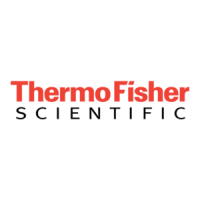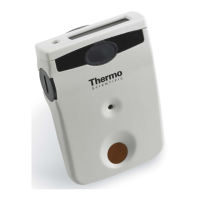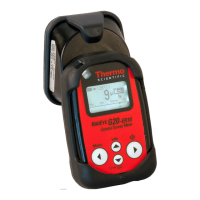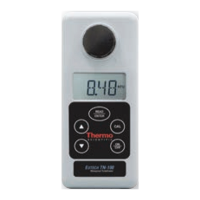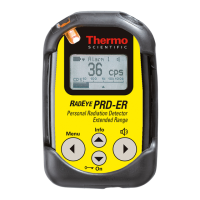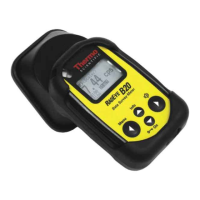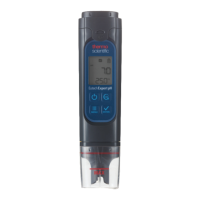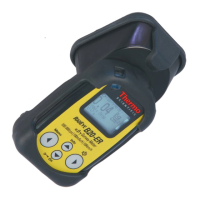Do you have a question about the Thermo Scientific Evolution 300 and is the answer not in the manual?
Explains safety precautions and important information formats used in the manual.
Provides contact information for technical assistance or questions regarding the instrument.
Identifies major visible components of a typical Evolution spectrophotometer.
Shows the locations and functions of various connectors on the spectrophotometer.
Describes standard rectangular cell holders and their installation process.
Details the procedure for installing and removing accessories in the sample compartment.
Describes the standard single cell holders supplied with the instrument.
Recommended for small aperture cells, allowing precise cell positioning.
Accommodates rectangular cells with pathlengths from 1 to 100 mm.
Designed for cylindrical cells with a 22 mm external diameter and up to 50 mm pathlength.
Accommodates square cells and operates at controlled temperatures (4-80°C).
Designed for test tubes or vials from 10 to 21 mm diameter and 40 to 100 mm high.
Allows use of 15 mm beam height filters and flow cells in the instrument.
Enables samples to be measured outside the main sample compartment.
Allows measurement of solid samples horizontally outside the instrument plane.
Provides capacity to measure various solid samples in % Transmittance mode.
Features auto-recognition, alignment, and serial number reporting for efficient operation.
Discusses accessories like internal printers that are factory installed or installed by service engineers.
Provides detailed steps for installing smart accessories with automatic alignment.
Explains how function keys operate within each screen and are shown at the display bottom.
Describes how to access major software functions from the main menu.
Details how to enter text items using the text entry screen and navigation.
Guides users on highlighting and editing numeric fields using the keypad.
Explains how to navigate and confirm choices within pop-up menus using arrow keys.
Describes how to store, view, access, and maintain files in the instrument Library or on disk.
Provides step-by-step instructions for running a Scan application.
Outlines the procedure for setting up and running a Fixed application.
Details the steps for setting up and running a Quantitation application.
Guides users through setting up and running a Kinetics application.
Explains how to set up and run a Multicomponent Analysis (MCA) application.
Details how to select and run specific nucleic acid tests like DNA and RNA analysis.
Covers various protein assays such as Bradford, Lowry, and BCA methods.
Describes how to measure cell growth using absorbance at 600nm.
Explains the calculator for determining oligonucleotide properties like Tm and MW.
Covers basic user-performed maintenance like keeping the interior dust-free.
Provides instructions for safely cleaning the exterior of the instrument.
Details how to open the housing and feed paper for the internal printer.
Advises on handling hot lamps and cooling the instrument before removal.
Step-by-step guide for replacing the deuterium lamp, including safety precautions.
Step-by-step guide for replacing the tungsten-halogen lamp, including safety precautions.
Refers to a separate guide for instructions on replacing the mercury lamp.
Explains safety precautions and important information formats used in the manual.
Provides contact information for technical assistance or questions regarding the instrument.
Identifies major visible components of a typical Evolution spectrophotometer.
Shows the locations and functions of various connectors on the spectrophotometer.
Describes standard rectangular cell holders and their installation process.
Details the procedure for installing and removing accessories in the sample compartment.
Describes the standard single cell holders supplied with the instrument.
Recommended for small aperture cells, allowing precise cell positioning.
Accommodates rectangular cells with pathlengths from 1 to 100 mm.
Designed for cylindrical cells with a 22 mm external diameter and up to 50 mm pathlength.
Accommodates square cells and operates at controlled temperatures (4-80°C).
Designed for test tubes or vials from 10 to 21 mm diameter and 40 to 100 mm high.
Allows use of 15 mm beam height filters and flow cells in the instrument.
Enables samples to be measured outside the main sample compartment.
Allows measurement of solid samples horizontally outside the instrument plane.
Provides capacity to measure various solid samples in % Transmittance mode.
Features auto-recognition, alignment, and serial number reporting for efficient operation.
Discusses accessories like internal printers that are factory installed or installed by service engineers.
Provides detailed steps for installing smart accessories with automatic alignment.
Explains how function keys operate within each screen and are shown at the display bottom.
Describes how to access major software functions from the main menu.
Details how to enter text items using the text entry screen and navigation.
Guides users on highlighting and editing numeric fields using the keypad.
Explains how to navigate and confirm choices within pop-up menus using arrow keys.
Describes how to store, view, access, and maintain files in the instrument Library or on disk.
Provides step-by-step instructions for running a Scan application.
Outlines the procedure for setting up and running a Fixed application.
Details the steps for setting up and running a Quantitation application.
Guides users through setting up and running a Kinetics application.
Explains how to set up and run a Multicomponent Analysis (MCA) application.
Details how to select and run specific nucleic acid tests like DNA and RNA analysis.
Covers various protein assays such as Bradford, Lowry, and BCA methods.
Describes how to measure cell growth using absorbance at 600nm.
Explains the calculator for determining oligonucleotide properties like Tm and MW.
Covers basic user-performed maintenance like keeping the interior dust-free.
Provides instructions for safely cleaning the exterior of the instrument.
Details how to open the housing and feed paper for the internal printer.
Advises on handling hot lamps and cooling the instrument before removal.
Step-by-step guide for replacing the deuterium lamp, including safety precautions.
Step-by-step guide for replacing the tungsten-halogen lamp, including safety precautions.
Refers to a separate guide for instructions on replacing the mercury lamp.
| Brand | Thermo Scientific |
|---|---|
| Model | Evolution 300 |
| Category | Measuring Instruments |
| Language | English |
